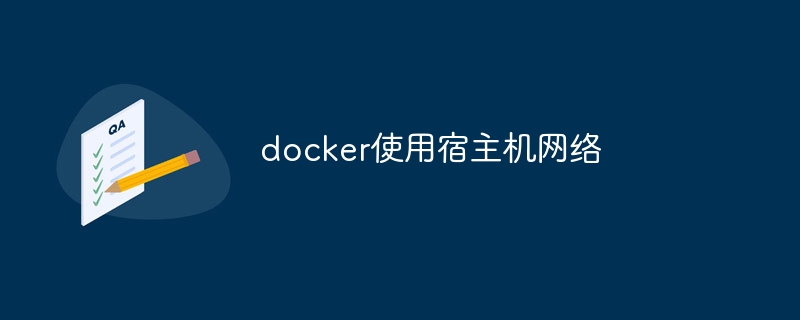Docker uses host network
Docker's host network mode allows containers to use host network resources. Features include: Sharing IP addresses and ports with the host, accessing the host file system, network configuration, and firewall. Notes include: security issues, resource conflicts and restrictions. Best practices recommend using this pattern when a container needs deep integration with the host, access to a specific resource, or is trusted. Alternatives include bridge mode, overlay network, and custom network.

Docker uses host network
When a Docker container needs to access host network resources (such as other containers, local services, or the Internet), the host network mode can be used.
Enable host network mode
When creating or starting a container, the host network mode can be enabled with --network=host flag. For example:
<code>docker run --network=host <image-name></image-name></code>
Advantages
Using host network mode has the following advantages:
- The container uses the same IP address and port as the host, simplifying network connections.
- The container can access file systems, sockets, and pipelines on the host.
- The container can use network configuration and firewall rules on the host.
Things to note
There are also some precautions when using the host network mode:
- Security issues: Containers share network stacks with hosts, and malicious containers may harm the hosts.
- Resource conflict: A container shares an IP address and port with the host, which may cause resource conflicts.
- Restrictions: Not all containers support host network mode.
Best Practices
For security and stability, it is recommended to use the host network mode in the following situations:
- The container needs to be deeply integrated with the host.
- The container needs to access specific resources or services on the host.
- The container is trusted and does not pose a security threat to the host.
Alternatives
In addition to the host network mode, there are other network modes available for Docker containers:
- Bridge mode: Create a virtual network isolated from the host.
- overlay network: Connect containers to a global, scalable virtual network.
- Custom network: Use user-defined network configuration.
The above is the detailed content of Docker uses host network. For more information, please follow other related articles on the PHP Chinese website!

Hot AI Tools

Undresser.AI Undress
AI-powered app for creating realistic nude photos

AI Clothes Remover
Online AI tool for removing clothes from photos.

Undress AI Tool
Undress images for free

Clothoff.io
AI clothes remover

Video Face Swap
Swap faces in any video effortlessly with our completely free AI face swap tool!

Hot Article

Hot Tools

Notepad++7.3.1
Easy-to-use and free code editor

SublimeText3 Chinese version
Chinese version, very easy to use

Zend Studio 13.0.1
Powerful PHP integrated development environment

Dreamweaver CS6
Visual web development tools

SublimeText3 Mac version
God-level code editing software (SublimeText3)

Hot Topics
 How to exit the container by docker
Apr 15, 2025 pm 12:15 PM
How to exit the container by docker
Apr 15, 2025 pm 12:15 PM
Four ways to exit Docker container: Use Ctrl D in the container terminal Enter exit command in the container terminal Use docker stop <container_name> Command Use docker kill <container_name> command in the host terminal (force exit)
 How to copy files in docker to outside
Apr 15, 2025 pm 12:12 PM
How to copy files in docker to outside
Apr 15, 2025 pm 12:12 PM
Methods for copying files to external hosts in Docker: Use the docker cp command: Execute docker cp [Options] <Container Path> <Host Path>. Using data volumes: Create a directory on the host, and use the -v parameter to mount the directory into the container when creating the container to achieve bidirectional file synchronization.
 How to check the name of the docker container
Apr 15, 2025 pm 12:21 PM
How to check the name of the docker container
Apr 15, 2025 pm 12:21 PM
You can query the Docker container name by following the steps: List all containers (docker ps). Filter the container list (using the grep command). Gets the container name (located in the "NAMES" column).
 How to restart docker
Apr 15, 2025 pm 12:06 PM
How to restart docker
Apr 15, 2025 pm 12:06 PM
How to restart the Docker container: get the container ID (docker ps); stop the container (docker stop <container_id>); start the container (docker start <container_id>); verify that the restart is successful (docker ps). Other methods: Docker Compose (docker-compose restart) or Docker API (see Docker documentation).
 How to start mysql by docker
Apr 15, 2025 pm 12:09 PM
How to start mysql by docker
Apr 15, 2025 pm 12:09 PM
The process of starting MySQL in Docker consists of the following steps: Pull the MySQL image to create and start the container, set the root user password, and map the port verification connection Create the database and the user grants all permissions to the database
 How to update the image of docker
Apr 15, 2025 pm 12:03 PM
How to update the image of docker
Apr 15, 2025 pm 12:03 PM
The steps to update a Docker image are as follows: Pull the latest image tag New image Delete the old image for a specific tag (optional) Restart the container (if needed)
 How to view the docker process
Apr 15, 2025 am 11:48 AM
How to view the docker process
Apr 15, 2025 am 11:48 AM
Docker process viewing method: 1. Docker CLI command: docker ps; 2. Systemd CLI command: systemctl status docker; 3. Docker Compose CLI command: docker-compose ps; 4. Process Explorer (Windows); 5. /proc directory (Linux).
 How to create containers for docker
Apr 15, 2025 pm 12:18 PM
How to create containers for docker
Apr 15, 2025 pm 12:18 PM
Create a container in Docker: 1. Pull the image: docker pull [mirror name] 2. Create a container: docker run [Options] [mirror name] [Command] 3. Start the container: docker start [Container name]






